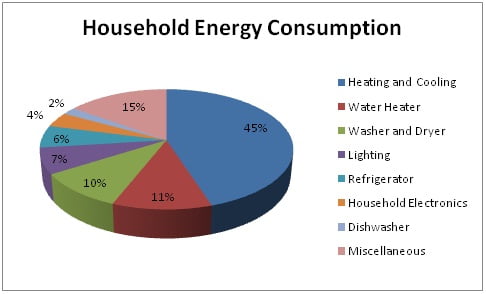Energy efficient improvements
Figure 1: Household Energy Consumption compiled from Consumer Reports: Greener Choices
Almost half of the household energy consumption comes from heating and cooling the home, so most energy-efficient improvements involve increasing the energy efficiency of the Heating, Ventilation, and Air Conditioning (HVAC) unit and keeping the warm or cool air indoors. When making improvements with an energy-efficient mortgage, the homebuyer is typically limited to improvements recommended in the HERS Report. Improvements recommended in the HERS Report must be cost-effective, which requires the annual energy savings from the improvements be greater than the annual increase in mortgage payments necessary to cover the costs of the improvements. Thus, the improvements vary dramatically from home to home.
Most homeowners are interested in replacing their existing HVAC units or appliances with upgraded energy-efficient versions, such as ENERGY STAR-rated ones. However, many homeowners have also used their energy mortgages to increase energy efficiency by installing:
- solar panels,
- tankless water heaters,
- increased insulation; and/or
- double-or triple-paned windows.
The costs for these improvements vary dramatically, and are dependent on the particular home’s needs. For instance, solar panel installation costs depend on sun exposure, energy consumption, climate, geography and a variety of other factors. There is no average cost for easy calculation, but the easiest way to get a free estimate for a solar panel installation is to use an online solar panel calculator. [For a solar panel installation calculator, see Find Solar’s Solar Calculator.]
A tankless water heater ranges from $500-$1500, and the installation costs can be up to $1,200. Insulation prices are trickier, as environmental factors play a large part in how much insulation a home needs. Double-paned windows cost an average of $600-$900, but the overall price is based on the number of windows requiring replacement.
Benefits of energy efficiency
Various federal and state tax credits are available to homebuyers and homeowners who take advantage of their energy-efficiency options. The federal government is offering homeowners and buyers a 30% tax credit for any of the following improvements:
- biomass stoves, which heat the home with biomass fuel made up of agricultural crops, trees, wood, wood waste and wood residues (wood pellets);
- HVAC systems;
- insulation;
- roofs (metal and asphalt);
- water heaters (non-solar or solar);
- windows and doors;
- geothermal heat pumps;
- small residential wind turbines; and
- solar panels. [For more information on energy efficient tax incentives, see the upcoming August 2010 first tuesday article, Energy efficiency in the home: Not just for hippies .]
California is also offering various tax incentives and rebate programs for energy-efficient improvements. [For a detailed list of energy efficient improvement rebates and incentives, see Flex Your Power California’s Rebates, Incentives, and Services.]
Why aren’t energy efficient mortgages more popular?
With so many tax benefits and monthly savings associated with increasing the energy efficiency of a residence, it is surprising that California buyers rarely inquire about energy mortgages from lenders or real estate licensees. Even among the brokers focused on green housing, current buyers are not concerned with energy consumption when purchasing single family residences. In such an environmentally progressive state, why aren’t more California homeowners opting to choose energy efficient mortgages?
The burst of the housing bubble coincided with the increased popularity of energy efficiency. As California was enacting energy efficiency requirements on cars, appliances and homes, the housing market was coming to a 30-year sales volume and pricing peak. As the housing bubble burst, it created a reasonable fear of negative equity among homebuyers. Thus, it follows that many homebuyers may be apprehensive about entering into a mortgage that initially puts their LTV at or above 100%.
The burst also brought the mortgage process under government scrutiny again, and homebuyers may be trying to avoid further complicating the loan application process. Many sellers attempting short sales may find their lender eager to quickly cash out on their investment in an underwater home. The extended escrow of 60-90 days, rather than the standard 30- 45-day escrow, may deter sellers from accepting the bid of a buyer with a pre-approved energy mortgage since everything is contingent on the lender approving the transaction.
The most probable cause for homebuyers’ lack of interest in energy mortgages: uninformed real estate professionals. Brokers and agents either do not know energy mortgages exist or fear them for lack of information about their approval process. Inquiries made of loan representatives for lenders regarding energy mortgages were responded with requests for time to research the topic so they could intelligently discuss them. While almost every lender, big or small, offers some version of an energy mortgage, their mortgage loan officers just don’t know about them.
Brokers and agents are not much different. Those focused on green housing or certified as EcoBrokers had information on the topic but not much experience. Like the lenders, many real estate licensees focusing on single family residences (SFRs) have absolutely no information to offer a homebuyer interested in an energy mortgage.
If an agent feels his client may be interested in pursuing eco-friendly living, or more generally, saving money on the monthly operating costs of a home, the agent needs to advise him of these energy-efficiency programs. With all of the incentives via tax subsidies and energy mortgages, the time to make more cost-effective energy efficient improvements is now.















Excellent information. Thank You.
A Key question remains however. Who are the Green Lenders, that have this knowledge, and can process loans without me having to educate them first??? I have yet to find one where the in-house brokers, even want to get involved with these kinds of loans. Too much to learn and too many hoops to jump through! So far – Direct Lenders who specialize in Green loans is the only way to go. Unfortunately, they are hard to find! A preferred list would be nice???